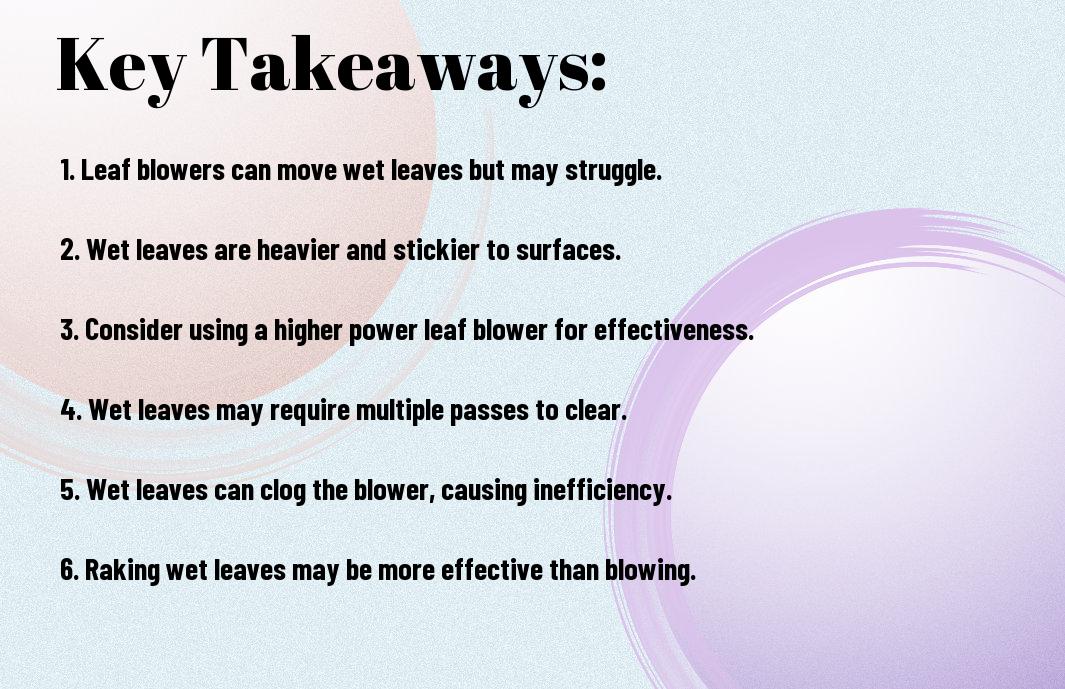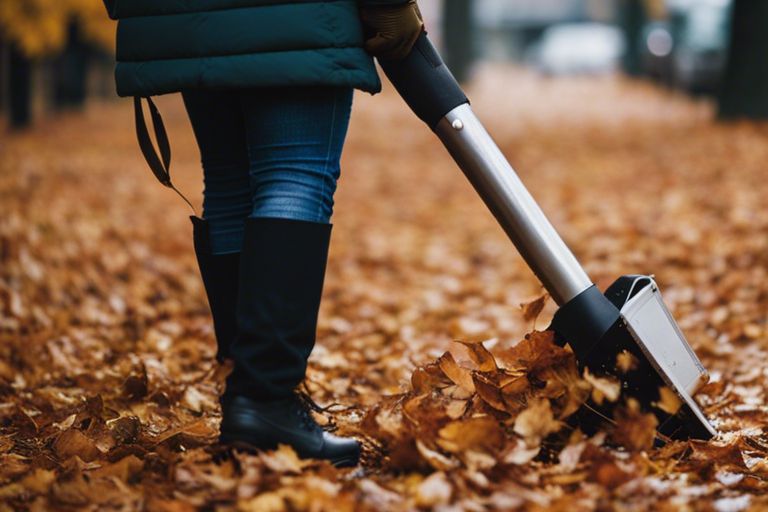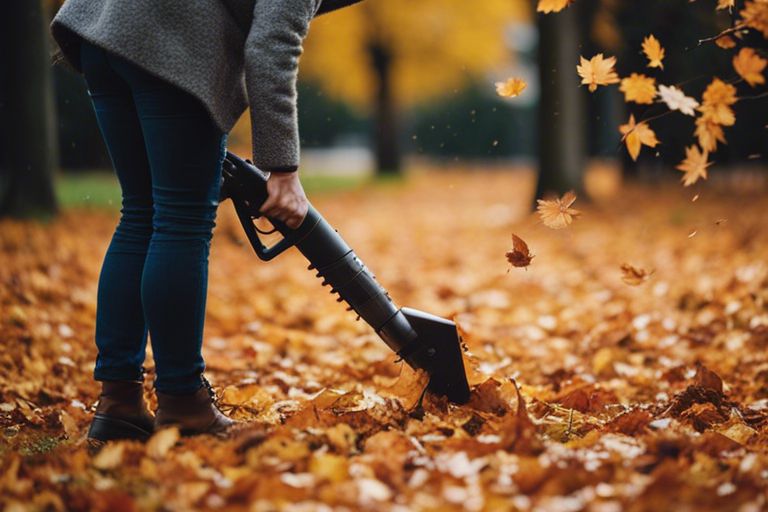Over the years, leaf blowers have become a handy tool for tidying up outdoor spaces. However, the question remains – do leaf blowers work effectively on wet leaves? Many homeowners find themselves facing this dilemma, especially during the fall season when leaves are damp from morning dew or recent rain. In this informative post, we will examine into whether leaf blowers are up to the task of clearing wet leaves and share some tips for maximizing their effectiveness.
Key Takeaways:
- Leaf blowers are not very effective on wet leaves: Wet leaves are heavier and tend to clump together, making it difficult for leaf blowers to move them effectively.
- Wet leaves can clog the leaf blower: Trying to use a leaf blower on wet leaves can lead to clogging, which can damage the blower and reduce its effectiveness.
- It is best to wait for leaves to dry before using a leaf blower: To ensure optimal performance, it is recommended to wait for the leaves to dry before using a leaf blower to clear them from your yard.


Leaf Blowers and Leaf Types
You may wonder if leaf blowers are effective on different types of leaves. The efficiency of a leaf blower can vary based on the type of leaves you are trying to clear. Recognizing the characteristics of various leaves can help you determine the best approach to tackle your yard work efficiently.
| Dry Leaves | Wet Leaves |
| Lightweight and easily blown away | Heavier and clump together |
| Quickly cleared with a leaf blower | May require more time and effort to remove |
| Less prone to clogging the blower | Higher chances of clogging the blower |
| Efficiently blown in one direction | May need multiple passes to clear effectively |
Dry Leaves Efficiency
Blowers work best on dry leaves as they are lightweight and easily blown away by the strong airflow. Dry leaves are less likely to clump together, allowing for quick and efficient clearing of your yard. They are less prone to clogging the blower, making the task smoother and less time-consuming.
Challenges with Wet Leaves
On the other hand, wet leaves pose challenges for leaf blowers. Wet leaves are heavier and tend to clump together, making it harder for the blower to disperse them effectively. They may require more time and effort to remove compared to dry leaves. Wet leaves also have a higher chance of clogging the blower, causing interruptions in your yard work.
With wet leaves, it is vital to adjust the blower settings and take your time to ensure thorough clearing. Consider using a higher power setting and making multiple passes to effectively remove wet leaves from your yard.
Mechanics of Leaf Blowers
Air Flow and Velocity
Many leaf blowers operate by creating a powerful stream of air that propels leaves and debris away. The force generated by the air flow, measured in miles per hour (mph), is crucial in determining the effectiveness of a leaf blower. Higher air velocity can dislodge and move stubborn wet leaves more easily compared to lower-velocity blowers.
Impact on Wet vs. Dry Surfaces
To understand the effectiveness of leaf blowers on wet leaves, it’s important to consider the impact of air on different surfaces. Wet leaves tend to stick together and adhere to the ground, making them harder to move. An ideal leaf blower should have the power to break through this cohesion and push the wet leaves effectively.
This requires a leaf blower with sufficient air velocity to dislodge the wet leaves without clogging the machine. Additionally, the design of the nozzle and airflow pattern plays a significant role in determining how well a blower can handle wet leaves.
Tips for Using Leaf Blowers on Wet Leaves
Unlike dry leaves, wet leaves can pose a unique challenge when using a leaf blower. However, with the right technique and considerations, you can still effectively clear your yard of wet leaves.
- Choose a high-powered leaf blower to ensure that it can handle the added weight and density of wet leaves.
- Start at a low setting and gradually increase the power to avoid clumping and clogging the blower.
- Use a sweeping motion, moving the blower from side to side to help dislodge the wet leaves more effectively.
Time of Day Considerations
One important consideration when using a leaf blower on wet leaves is the time of day. Early morning is an ideal time as the leaves are likely to be drier from overnight dew. Avoid blowing wet leaves in the late afternoon when they may have accumulated more moisture throughout the day.
Techniques for Improved Efficiency
For improved efficiency when using a leaf blower on wet leaves, consider adjusting your technique. Instead of focusing on blowing the leaves in one direction, try using a back-and-forth motion to break up clumps and disperse the leaves more evenly.
Leaves that are too wet or heavy may need to be cleared manually before using the leaf blower to prevent clogs and ensure optimal performance. By following these tips and techniques, you can effectively use a leaf blower to clear wet leaves from your yard with ease.

Alternatives to Leaf Blowers for Wet Leaves
Manual Tools and Techniques
Now, when dealing with wet leaves, using manual tools and techniques can be a more effective alternative to leaf blowers. Rakes, hand-held leaf scoops, and tarps are all great options for clearing wet leaves without the hassle of a noisy blower.
Powered Equipment Options
Blowers, on the other hand, can struggle with wet leaves as they can get clogged or the moisture can weigh them down, making them less effective. In this case, powered equipment options like vacuum mulchers or leaf shredders can be more efficient in handling wet leaves. These machines are designed to handle heavier loads and can make quick work of wet leaf cleanup.
The key to effectively managing wet leaves is to choose the right tool for the job. While leaf blowers can be handy for dry leaves, they may not be the best option for wet leaves. Investing in a vacuum mulcher or leaf shredder can save you time and effort when faced with damp, heavy foliage. Consider these alternatives for a cleaner and more efficient leaf cleanup process.
Final Words
So, in conclusion, while leaf blowers can be effective at clearing dry leaves, they struggle when it comes to wet leaves. The design and function of leaf blowers make them more suited to dry debris, making wet leaves a challenge for them to handle effectively. It’s best to use alternative methods such as a rake or a leaf vacuum to tackle wet leaves and ensure a clean and tidy yard.
FAQ
Q: Do leaf blowers work effectively on wet leaves?
A: Leaf blowers can still work on wet leaves, but they may be less effective than on dry leaves. Wet leaves tend to clump together and may require more effort to blow away.
Q: Can using a leaf blower on wet leaves damage the machine?
A: Using a leaf blower on wet leaves can potentially cause damage to the machine, as the moisture can affect the motor and other components. It is recommended to check the manufacturer’s guidelines before using a leaf blower on wet leaves.
Q: Are there specific types of leaf blowers that are better for wet leaves?
A: Some leaf blowers are designed specifically to handle wet leaves better than others. Look for models with high airspeed and airflow to effectively move wet leaves.
Q: How can I make leaf blowing more effective on wet leaves?
A: To make leaf blowing more effective on wet leaves, try using the highest setting on your leaf blower and work in small sections. You can also use a rake to loosen up the wet leaves before using the leaf blower.
Q: Are there any safety precautions to keep in mind when using a leaf blower on wet leaves?
A: When using a leaf blower on wet leaves, be cautious of slippery surfaces and potential hazards hidden beneath the leaves. Wear appropriate footwear with good traction and be mindful of your surroundings to prevent accidents.
